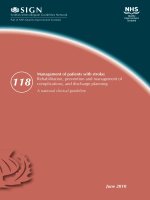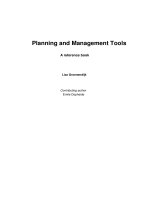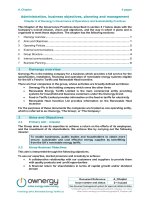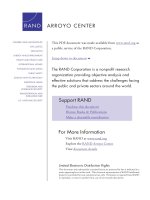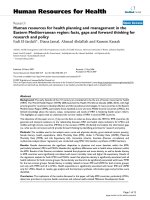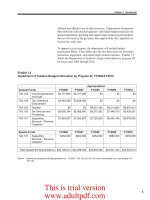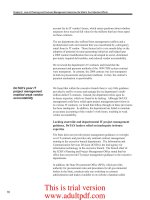Airport planning and management
Bạn đang xem bản rút gọn của tài liệu. Xem và tải ngay bản đầy đủ của tài liệu tại đây (14.37 MB, 454 trang )
Planning
& Management
G««
ri ISfl
Education
Tai Lieu Chat Luong
Seth B. Young I Alexander T. Wells
Airport
Planning and
Management
About the Authors
S eth B . Y oung, Ph.D.,
is the McConnell Chair Aviation
in the College of Engineering at The Ohio State
University in Columbus, Ohio. Dr. Young has extensive
experience in airport management consulting and is
an accredited airport executive (AAE) with the
American Association of Airport Executives. Dr. Young
holds an instrument-rated FAA commercial pilot and
certified flight instructor certificate. He is the co-author
of Planning and Design of Airports, Fifth Edition, also
from McGraw-Hill.
T. W ells, Ed.D., retired professor at the
College of Business at Embry-Riddle Aeronautical
University in Daytona Beach, Florida, is a consultant
to airport management with over 30 years of
experience. He is the author of such leading texts as
Commercial Aviation Safety, Second Edition, also from
McGraw-Hill.
A lexander
Airport
Planning and
Management
Seth B. Young
Alexander T. Wells
Seventh Edition
TRƯỚNG ĐẠI HỌC QUY NHƠN
THƯ VIỆN______ :
310/ A - l T
ỉ
Mc
G raw
Hill
Education
New York Chicago San Francisco
Athens London Madrid
Mexico City Milan New Delhi
Singapore Sydney Toronto
Library of Congress Control Number: 2018956780
McGraw-Hill Education books are available at special quantity discounts to use as premiums
and sales promotions, or for use in corporate training programs. To contact a representative
please visit the Contact Us page at www.mhprofessional.com.
Airport Planning and Management, Seventh Edition
Copyright ©2019 by McGraw-Hill Education. All rights reserved. Printed in the United States
of America. Except as permitted under the United States Copyright Act of 1976, no part of this
publication may be reproduced or distributed in any form or by any means, or stored in a data
base or retrieval system, without the prior written permission of the publisher.
1 2 3 4 5 6 7 8 9
LCR 23 22 21 20 19
ISBN 978-1-260-14332-4
MHID 1-260-14332-5
The pages within this book were printed on acid-free paper.
Sponsoring Editor
Lauren Poplawski
Copy Editor
Dipti Barthwal
Composition
Cenveo Publisher Services
Editorial Supervisor
Donna M. Martone
Proofreader
Kannathal
Art Director, Cover
Jeff Weeks
Production Supervisor
Pamela A. Pelton
Indexer
Robert Swanson
Project Manager
Surbhi Mittal,
Cenveo5 Publishers Services
Acquisitions Coordinator
Elizabeth Houde
Information contained in this work has been obtained by McGraw-Hill Education from sources believed to be reliable. H ow ever,
neither McGraw-Hill Education nor its authors guarantee the accuracy or com pleteness of any inform ation published herein,
and neither McGraw-Hill Education nor its authors shall be responsible for any errors, omissions, o r d am ag es arising o u t o f use
of this information. This work is published with the understanding that M cGraw-Hill Education and its auth ors are supplying
information but are not attempting to render engineering or other professional services. If su ch services are required, the
assistance of an appropriate professional should be sought.
Contents
Preface
.........................................................................................................................
A cknow led gm ents
..................................................................................................
Part I
1
2
xv
xxi
Airports and Airport Systems
....................................
3
O bjectives ....................................................................................................................
Introduction ................................................................................................................
The W orld's A irports
.............................................................................................
A irports in the U nited States
...............................................................
The N ational (and International) O versight of A irports
.......................
The N ational Plan of Integrated A irport System s
.....................................
The Rules that G overn A irports
........................................................................
Professional O rganizations Supporting A irport M anagem ent
............
C oncluding Rem arks
.............................................................................................
Key Term s
....................................................................................................
Q uestions for Review and D iscussion ............................................................
Suggested Readings
...............................................................................................
Suggested Internet Resources ...............................................................
Airports and Airport Systems: An Introduction
3
3
4
7
14
16
21
24
26
26
27
28
28
Airports and Airport Systems: Organization and Administration
29
...
O bjectives ....................................................................................................................
Introduction ...............................................................................................................
A irport O w nership and O peration
.................................................................
A irport Privatization
...............................................................................
The A irport O rganization C hart ........................................................................
Job D escriptions
............................................................................................
A irport M anagem ent as a Career .....................................................................
Duties of an A irport M anager
................................................................
Education and Training ..........................................................................
The A irport M anager and Public Relations
....................................................
The A irport M an ager's C onstituents ....................................................
Public Relations O bjectives .......................................................................
C oncluding Rem arks
............................................................................................
Key Terms
...................................................................................................
Q uestions for Review and D iscussion ............................................................
Suggested Readings
...........
Web References ...........................................................................................................
29
29
29
31
33
34
41
42
43
44
46
47
48
48
49
49
50
V
vi
Contents
3
Airports and Airport Systems: A Historical
and Legislative Perspective .........................................................................
51
Objectives ..............................................................................................................
51
Introduction ..........................................................................................................
51
Tne Formative Period of Aviation and Airports: 1903-1938
................
52
The Birth of Civil Aviation: 1903-1913
............................................
52
World War 1 :1914-1918 ........................................................................
52
Early Airmail Service: 1919-1925
52
The Air Commerce Act: 1926-1938
53
The Civil Aeronautics Act: 1938-1939 ..............................................
56
Airport Growth: World War II and the Postwar Period
..........................
57
The Federal Airport Act: 1946 .............................................................
58
Airport Modernization: The Early Jet Age ..................................................
59
The Airways Modernization Act of 1957
.......................................
59
The Federal Aviation Act of 1958 .......................................................
61
The Department of Transportation: 1967
.......................................
61
The Airport and Airway Development Act of 1970
...................
63
Environmental Policies of the 1970s
................................................
64
The National Airport System Plan ....................................................
65
The Airport and Airway Development
Act Amendments of 1976 ...............................................................
66
Airport Legislation After Airline Deregulation .........................................
68
The Deregulation Acts of 1976 and 1978 .........................................
68
The Airport and Airway Improvement Act of 1982
...................
70
The Aviation Safety and Capacity Expansion Act of 1990
....
71
Military Airport Program
....................................................................
73
The Aviation Security Improvement Act of 1990 .........................
74
The Airport and Airway Safety, Capacity, Noise Im provem ent,
and Intermodal Transportation Act of 1992 ..............................
74
The AIP Temporary Extension Act of 1994 .....................................
75
The Federal Aviation Administration Authorization
Act of 1994
.........................................................................................
75
The Federal Aviation Reauthorization Act of 1996
.....................
75
Airport Legislation in the Twenty-First Century .......................................
76
AIR-21: The Wendell H. Ford Aviation Investm ent
and Reform Act for the Twenty-First Century
.......................
^
The Aviation and Transportation Security Act of 2001
..............
^8
Homeland Security Act of 2002
.........................................................
^
Vision 100—Century of Aviation Reauthorization Act of 2003
FA A Modernization and Reform Act of 2012 .......................
FA A Extension, Safety, and Security Act of 2016 ................
Continuing Resolutions and Extensions of 2017 and 2018
Concluding Remarks ..............................................................................
Key Acts of Legislation
............................................................
Key Organizations and Administrations
...........................
Key Plans, Programs, and Policies .........................................
Contents
Q uestions for Review and D iscussion .............................................................
Suggested Readings
..........................................................
Web R esources
.........................................................................................................
Part II
4
5
84
85
86
Airport Operations Management
...........................................................................................................
89
O bjectives .....................................................................................................................
The C om ponents of an A irport ...........................................................................
The A irfield
................................................................................................................
Runw ays
.......................................................................................................
A R u n w ay's Im aginary Surfaces
........................................................
Taxiw ays
......................................................................................................
O ther A irfield M arkings
........................................................................
O ther A irfield A reas
...............................................................................
A irfield Signage
........................................................................................
A irfield Lighting ......................................................................................................
R unw ay Lighting
......................................................................................
Taxiw ay Lighting
......................................................................................
O ther A irfield Lighting
..........................................................................
N avigational A ids Located on A irfields
........................................................
N ondirectional Radio Beacons
............................................................
Very-High-Frequency Omnidirectional
Range Radio Beacons
...........................................................................
Instrum ent Landing System s
..............................................................
A ir Traffic Control and Surveillance Facilities Located
on the A irfield
...................................................................................................
A ir Traffic C ontrol Towers .....................................................................
A irport Surveillance Radar ...................................................................
A irport Surface D etection Equipm ent ..............................................
W eather Reporting Facilities Located on A irfields
...................................
W ind Indicators
........................................................................................
Security Infrastructure on Airfields .................................................................
C oncluding Rem arks
............................................................................................
Key Terms
...................................................................................................
Q uestions for Review and D iscussion ............................................................
Suggested Readings
..............................................................................................
The Airfield
89
89
90
91
103
106
110
112
114
119
119
127
128
129
129
134
134
134
135
135
137
137
137
138
139
140
Airspace and Air Traffic Management
.......................................................
141
O bjectives ...................................................................................................................
Introduction ..............................................................................................................
Brief H istory of A ir Traffic Control
................................................................
The Present-D ay Air Traffic Control M anagem ent
and O perating Infrastructure .......................................................................
The FAA's A ir Traffic O rganization
..................................................
Air Traffic Control System Com m and C enter
..............................
141
141
141
129
131
145
145
145
vil
VIU
Contents
The Basics of Air Traffic Control ......................................................
Visual Flight Rules Versus Instrument Flight Rules
..
Victor Airways and Jet Ways
.............................................
Special-Use Airspace
............................................................
Flight Service Stations
..........................................................
Terminal Area Air Traffic Control Procedures
..............
Traditional and M odem "N extG en" Procedures .........
Current and Future Enhancements to Air Traffic M anagem ent
Performance-Based Navigation
.........................................
Modernized Approaches to Airports ................................
Airport Surface Movement Management
.....................
Concluding Remarks .........................................................................
Key Terms
................................................................................
Questions for Review and Discussion ..........................................
Suggested Readings ...........................................................................
Web Reference ................................
Airport Operations Management Under 14 CFR Part 13
Objectives .......................................................................................
Introduction ...................................................................................
Part 139 Airport Classifications
...............................................
Inspections and Compliance .....................................................
Specific Areas of Airport Management of Importance
to Airports Found in 14 CFR Part 139 .............................
Pavement Management ...............................................
Aircraft Rescue and FireFighting .............................
Snow and Ice Control ...................................................
Bird and Wildlife Hazard Management
................
Self-Inspection Programs .........................................................
SMS—Safety Management Systems for Airports
...........
Concluding Remarks ...............................................................
Key Terms
......................................................................
Questions for Review and Discussion .................................
Suggested Readings ..................................................................
Airport Terminals and Ground Access
Objectives ...................
Introduction .............
The Historical Develop
Unit Terminal C
Linear Terminal
Pier Finger Terminals
.........................................
Pier Satellite and Remote Satellite Terminals
The Mobile Lounge or Transporter Concept
Hybrid Terminal Geometries
......................
The Airside-Landside Concept
.........
147
.........
147
.........
152
.........
152
.........
153
.........
153
.........
153
.........
158
...........
161
...........
164
............ 165
............ 165
............ 165
............ 167
............ 168
............ 168
...........
169
............
............
............
............
169
169
170
171
............
............
.............
.............
..............
..............
..............
..............
..............
..............
..............
174
174
179
183
189
191
195
197
198
198
199
.............
201
..............
..............
..............
..............
..............
..............
201
201
202
202
205
207
207
209
210
211
................
Contents
O ff-A irport Term inals
.............................................................................
Present-D ay A irp ort Term inals .............................................................
C om ponents of The A irp ort Term inal .............................................................
The A pron and G ate System
.................................................................
A ircraft G ate M anagem ent
....................................................................
The Passenger H andling System
........................................................
A irp ort G round A ccess
.........................................................................................
A ccess From the C BD and Suburban A reas
to the A irport Boundary
....................................................................
A ccess M odes
.............................................................................................
Factors Influencing D em and for G round A ccess ..........................
C oordination and Planning of G round A ccess
Infrastructure
........................................................................................
A ccess From the A irport Boundary to Parking A reas and
Passenger U nload ing C urbs at the Term inal Building .........
Vehicle Parking Facilities ........................................................................
Technologies to Im prove Ground A ccess to A irports
................
C oncluding Rem arks
.............................................................................................
K ey Term s
....................................................................................................
Q uestions for Review and D iscussion ............................................................
Suggested Readings
...............................................................................................
8
Airport Security
213
213
214
214
216
218
230
230
231
233
234
235
235
239
242
243
245
246
..................................................................................................
247
O bjectives ....................................................................................................................
Introduction ...............................................................................................................
H istory of A irport Security
.................................................................................
A viation Security post-Septem ber 11, 2001 ...................................................
A viation Security Roles
........................................................................................
Security at C om m ercial Service A irports
.....................................................
The A irport Security Program
............................................................
A irport Security A reas as Defined in the A SP
..............................
Em ployee Identification
........................................................................
Law Enforcem ent, C ontingencies, and Incident Response
...
Passenger Screening .................................................................................
C hecked-Baggage Screening ................................................................
C ontrolled A ccess .....................................................................................
Perim eter Security
...................................................................................
Security at G eneral Aviation A irports
............................................................
TSA G uidance for G eneral Aviation A irport Security ................
A irspace Security and Tem porary Flight Restrictions
............................
The Future of A irport Security
.........................................................................
C oncluding Rem arks
............................................................................................
Key Terms
...................................................................................................
Q uestions for Review and Discussion ............................................................
Suggested Readings
..............................................................................................
247
247
248
252
257
258
258
259
260
262
263
267
269
269
271
273
274
276
276
277
277
278
¡x
X
Contents
Part III Airport Administrative Management
9
Airport Financial Management
Objectives
Introduction .............
Airport Financial Accounting ’
Operating Expenses
Liability Insurance .............
......................................................
Airport Liability C overage.......................................................
Operating Revenues
...................................................
,U; 7
e. f at Commercial Airports
The Residual Cost Approach
Net Income
.
d ComPensat°ry Approaches
Majority-m-Interest C lau ses.................................................
Pricing of a ° f USe ASreemer>ts . . .
........................................
Pricing of A'■port Facilities and Services
Pncmg on the Airfield Area
Facilities anH i?
ã
Gran,aram P ' 08 ô đ
^^
............................
A^ ô R n a ' „ t r ces
...........
........
............
Community ¿ n Chf 1868 ...........! ........
Current Financial sTfCBaSe
T
:mgS
Interest Costs
defaults
........
u sa n d D e b ,lw l'
283
283
283
284
285
286
286
287
288
289
290
291
291
291
292
293
293
294
295
295
296
297
297
298
299
299
300
303
304
304
304
305
306
306
306
307
308
308
308
309
309
309
310
310
311
Contents
Private Investm ent
..................................................................................................
Build, O perate, and Transfer C ontracts . . ........................................
Lease, Build, and O perate A greem ents ............................................
Full Privatization
......................................................................................
C onclud ing Rem arks
.............................................................................................
K ey Terms
....................................................................................................
Q uestions for R eview and D iscussion .............................................................
Suggested Readings
................................................................................................
311
312
312
312
313
314
314
315
10
A irp orts and T h e ir R ela tio n sh ip s to the Econom y,
the E n viron m en t, and the C om m u n ities T h ey Serve ............................
317
O bjectives ....................................................................................................................
317
Introduction ................................................................................................................ 318
The Econom ic C ontribution of A irports
........................................................
318
Transportation Role
.................................................................................
318
Stim ulating Econom ic G row th
............................................................
318
The A irp ort's Strategic Relationships
............................................................
319
A irp ort-A irlin e Relations
...................................................................... 320
A irp ort-T en an t Relations
...................................................................... 321
A irp ort-G en eral Aviation Relations
................................................. 322
A irports and the Environm ent ..........................................................................
323
A irport N oise Im pacts
............................................................................
323
M easurem ent of N oise ............................................................................
324
A ir Q uality .................................................................................................... 326
W ater Q uality
............................................................................................. 327
H azardous W aste Em issions ................................................................. 327
Externalities .................................................................................................
328
Econom ic and Environm ental Sustainability Practices
............ 328
A irport-C om m unity Relations
..........................................................................
328
A irport C om m unications
...................................................................................
329
C oncluding Rem arks
............................................................................................
329
Key Terms
...................................................................................................
330
Key A cts ........................................................................................................ 330
Key Federal Aviation Regulations
. ...................................................
330
Q uestions for Review and D iscussion ............................................................
330
Suggested Readings
...........................................
331
11
A irport P lan n in g
...................................................................................................
O bjectives ...................................................................................................................
Introduction ..............................................................................................................
Defining the Planning H orizon
.........................................................
A irport System Planning .....................................................................................
N ational-Level System Planning
.......................................................
Regional-Level System Planning
.......................................................
State-Level System Planning ................................................................
333
333
333
334
334
334
335
337
xi
xii
Contents
The Airport Master Plan
. . . . •••••
’ .................... .. *
Objectives of the Airport M aster Plan ..............
Elements of the Master Plan .............................................
Inventory ..................................... *
‘‘7 *
Historical Review of Airports and Facilities ................
The Airport Layout Plan .................................................................
Forecasting ...................................................................................
Qualitative Forecasting Methods ....................................
Quantitative Methods
........................................................
Regression Analysis ............................................................
Forecasts of Aviation Demand
........................................
Facilities Requirements
..................................................................
Aircraft Operational Requirements .............................
Capacity Analysis ..............................................................
Design Alternatives
.......................................................................
Site Selection .......................................................................
Runway Orientation and Wind Analysis
..................
Airspace Analysis ..............................................................
Surrounding Obstructions
.............................................
Availability for Expansion ...............................................
Availability of Utilities .....................................................
Meteorological Conditions
..........................................
Economy of Construction .............................................
Convenience to Population ..........................................
Cost Comparisons of Alternative Plans and Designs
Terminal Area Plans .......................................................
Airport Access Plans
.....................................................
Financial Plans
.............................................................................
Economic Evaluation .....................................................
Break-Even Need
...........................................................
Potential Airport Revenue ..........................................
Final Economic Evaluation ........................................
Land Use Planning ....................................................................
Land Uses on the Airport
..........................................
Land Uses Around the Airport .................................
Environmental Planning
Concluding Remarks ................................................................
Key Terms
..................................................
Questions for Review and Discussion
Suggested Readings ................................ *
....................
12
Airport Capacity and Delay .................................................
Objectives ..................................
Introduction .....................
Defining Capacity ................................
Factors Affecting Capacity and Delay
...........
338
339
339
340
340
343
345
346
347
348
348
351
351
351
352
352
353
354
355
355
355
356
. 356
. 356
. 357
. 357
. 361
. 361
. 361
. 362
. 363
.. 364
. . 364
. . 365
. . 365
. . 366
. . 368
. . 369
. . 370
. . 371
...
373
...
...
...
...
373
373
374
377
Contents
Estim ating C apacity
................................................................................................
Illu strating C apacity W ith a Tim e-Space D iagram
...................................
FAA A pproxim ation C harts
...............................................................................
Sim ulation M odels
..................................................................................................
FAA's A irp ort C apacity Benchm arks .................................................
D efining D elay
.........................................................................................................
Estim ating D elay
....................................................................................................
A nalytical Estim ates of D elay: The Q ueuing D iagram ............................
O ther M easures of D elay ......................................................................................
A pproaches to R educing D elay
........................................................................
C reating N ew A irport Infrastructure
...............................................
C onverting M ilitary A irfields ...............................................................
A d m inistrative and D em and M anagem ent
.................................................
A dm inistrative M anagem ent
...............................................................
D em and M anagem ent .............................................................................
C oncluding Rem arks
.............................................................................................
K ey Terms
....................................................................................................
Q uestions for Review and D iscussion ............................................................
Suggested Readings
...............................................................................................
13
The Future of Airport Management
380
382
386
387
389
389
391
392
394
394
395
395
396
396
399
401
401
402
403
..........................................................
413
O bjectives ....................................................................................................................
Introduction ...............................................................................................................
Review ing and Revising Previous Predictions
..........................................
Restructuring of C om m ercial A ir C arriers
.....................................
N ew Large Aircraft, the Airbus A-380 and the Boeing 747-8 . . . .
Sm all A ircraft Transportation System s (SATS)
and U nm anned A erial System s (UAS)
.......................................
The Future O utlook for A irport M anagem ent ............................................
Enhanced Safety
........................................................................................
Environm ental Sustainability
..............................................................
FAA Reauthorization
..............................................................................
Future Financial and M arketing Strategies .....................................
N extG en Im plem entation
.....................................................................
G lobalization ..............................................................................................
A ccom m odating N ew Technologies: The Sm art A irport
.........
A irport C ities ..............................................................................................
C oncluding Rem arks
............................................................................................
Key Terms
...................................................................................................
Q uestions for Review and D iscussion ............................................................
Suggested Readings
..............................................................................................
413
413
414
414
414
415
417
418
418
419
419
420
420
420
421
421
422
422
422
Index
423
An
.....................................................................................................................
online glossary can be found at YVYvw.mhprofessional.com/voungZo
xiil
Preface
n 1986, the first edition of Airport Planning and M anagement pioneered an innovative
structure for a basic airport principles course designed for two similar, yet distinct,
markets: the college student enrolled in an aviation prorgam, seeking to gain insight
into a possible future career in airport management, as well as someone currently in the
field of airport management or operations who is seeking further education toward
career advancement. Since that time, five subsequent editions of the text were published,
each edition reflecting updates that have occurred in the constantly evolving aviation
industry. The response of both professors and students over the years has been
gratifying. Airport Planiting and Management and its accompanying test bank have been
more widely used than any other teaching material for an airport course.
In the thirty-two years since the first edition of this text was published, the world of
civil aviation, including airport management, has witnessed tremendous changes in
technology, structure, and political environments. The aviation industry adjusted to
major regulatory change, experienced economic woes, experienced record economic
prosperity, adapted to a new world of enhanced security, and most recently, struggled
through a worldwide economic downturn, and is poised for an entirely new paradigm
of technology. In addition, the world of airport management has continued to evolve
into more of an analytic and business-oriented discipline, applying theories of
operations, economics, finance, customer service, communications, and public
administration to adapt to ever-changing environments.
With the retirement of Dr. Alex Wells, Dr. Seth Young has taken on the sole
responsibility for updating this text for its next and future editions. Dr. Young, with
assistance and guidance from other key leaders in the airport industry, has made it a
priority to bring the seventh edition of Airport Planning and Management to a new
standard of quality as a resource for current and future airport managers. The entire text
has been critically revised, and updated. In addition, significant text has been added and
rewritten. Clear and interesting communication has been a priority, as in past editions.
Recognizing that a course in airport planning and management is normally a
student's first exposure to the field, this text provides a significant amount of
introductory material. While no one text can be the exhaustive source on any particular
topic, this text attempts to provide a body of information that will allow students to
gain knowledge of the various facets of airport planning and management at a
fundamental, yet also comprehensively rich, level. The focus of this text is to build a
solid foundation of understanding of all the elements that are of concern to airport
management. Influenced by the combined experience of more than 60 years in teaching
I
XV
xvi
Preface
aviation management at the college level, the authors, current and retired, believe that
the information contained in this text is commensurate with university level study.
It is recognized that instructors will supplement the material found in this text with
current case studies, examples drawn from their own experiences, timely news and
Internet sources, and industry and academic journals. Students are encouraged to
explore and keep abreast of current periodicals, such as Airport, Airport Business, Air
Transport World, and Aviation Week, as well as be consistent in keeping up to date with
the latest airport related events, and airport communications found on the Internet. It is
hoped that the ability to reason accurately and objectively about issues facing airports
and the development of a lasting interest in airport planning and management will be
two valuable byproducts of the text's basic objectives.
Organization of the Seventh Edition
The nearly eight years since the publication of the sixth edition of this text witnessed
another cycle in the United States' national economy, from the "Great Recession" to full
economic recovery, as evidenced from an airline industry fraught with bankruptcies
and mergers to a consolidated industry of profitable air carriers. Air traffic has reached
record levels. Aircraft technology has improved, resulting in air service between new
markets. Other technologies, from the proliferation of the NextGen air traffic
management system, to the emergence of Unmanned Aerial Systems, to the proliferation
of Internet-based communications and "smart" technologies, have created new
opportunities and challenges for airport management. This seventh edition attempts to
address the new environment, while not forgetting the fundamentals of airport planning
and management.
The text is once again organized into three parts: Airports and Airport Systems,
Airport Operations Management, and Airport Administrative Management. Each part
is designed to address airport planning and management from specific perspectives.
Part I: Airports and Airport Systems
Part I provides an overview of airports from a systems perspective and provides
background and historical information regarding the development of airports and the
rules that airport management must adhere to. Within this part are three chapters.
Chapter 1: Airports and airport systems: An introduction provides a comprehensive
overview of airports in the United States, the national administrative structure of
airports, and basic definitions that describe airports and types of airport activity.
Chapter 2: Airports and airport systems: Organization and administration describes the
public and private ownership and administrative structures that exist for civil
use airports in the United States and internationally. A comprehensive sample
of employment positions that exist at airports is presented, as are descriptions
of the duties of the airport manager, and an introduction to the public relations
issues facing airport management.
Chapter 3: Airports and airport systems: A historical and legislative perspective includes
an account of the development of airports within the civil aviation system that
has been thoroughly reviewed and updated through 2017, including the latest
short-term funding legislation.
Preface
Part II: Airport Operations Management
Part II has been written to provide the airport management student, as well as the new
airport m anagement employee, with a comprehensive information source describing
the facilities and operations that exist within an airport's property including the airfield,
airspace, terminals, and ground access systems. This part may be valuable not only as
a text but also as a reference guide for those not in academic study. Within this part are
five chapters.
Chapter 4: The airfield describes the facilities that exist on an airport to facilitate the
operation of aircraft, including a full description of runways, taxiways, and
navigational aids, along with associated signage, lighting, and markings. Much
of the information contained in this chapter is sourced directly from the Federal
Aviation Adm inistration's A irm ans Information M anual a guide designed to
provide pilots of civil aircraft with full descriptions of the aviation environment.
Chapter 5: Airspace and air traffic management provides a fundamental, yet detailed,
description of the national airspace and air traffic control system, as it relates to
airport management. A brief history of air traffic control is provided, as is a
description of the management structure of the current air traffic control
system. The basics of air traffic control are described, including the various
classes of airspace and the rules by which they are operated. In addition, a
description of the current and future planned enhancements to the air traffic
control system is provided, to allow the airport manager to best prepare for the
future of air traffic management.
Chapter 6: Airport operations management under 14 CFR Part 139 discusses how the
facilities described in Chapters 4 and 5 must be managed at airports certified
to accommodate commercial air service under FAR Part 139— Certification of
Airports.
Chapter 7: Airport terminals and ground access describe the infrastructure used to
facilitate the transfer of passengers and cargo between aircraft and their
ultimate origins and destinations within a metropolitan area. The chapter
includes a historical account of the development of airport terminals, a
description of the various airport terminal geometries that have been
constructed, the components of the airport terminal, including aircraft aprons
and gates, passenger processing facilities, and vehicle access facilities, such as
roadways, curbsides, parking lots, and public transit systems. The chapter is
updated to address the adaptation of new airport terminal technologies and
ground transportation business models.
Chapter 8: Airport security has been updated to describe the historical, current, and
possible future of the operation of an airport from security perspectives.
Historical accounts of airport security-related events are described, as is a
comprehensive analysis of the events of September 11,2001. The Transportation
Security Administration and the associated regulations that affect airport
management are discussed. In addition, current and future technologies that
may be used to enhance airport security are described.
xvil
xviii
Preface
Part III: Airport Administrative Management
Part III has been designed to provide the airport management student with fundamental
concepts and regulations that govern the administrative side of airport planning and
management. This part focuses on the financial, administrative, and planning aspects
of airport management. This part contains five chapters.
Chapter 9: Airport financial management presents the various strategies that exist to
account and pay for the land, labor, and capital required to maintain financially
stable airport operations and development. Airport accounting strategies are
described, as are issues concerning airport insurance, revenue generating
strategies, airport budgeting, and airport funding and financing strategies.
Chapter 10: The economic, political, and social role o f airports describes the impacts that
airports have on their surrounding communities, including the economic
benefits of additional transportation service and associated economic activity
and the environmental impacts such as noise, air and water quality, and
industrialization. In addition, the political role of airport management when
dealing with tenants of the airport and the outside community is described.
Chapter 11: Airport planning describes the strategies employed on local, regional,
and national levels to prepare airports for future aviation activity. The chapter
describes system planning on national and regional levels, and focuses on
airport master planning, including demand forecasting, airport layout plans,
runway orientation, land use planning, obstruction clearances, terminal area
plans, and economic evaluation of planning alternatives. This chapter is
designed to prepare the university level student for more advanced study in
airport planning and design.
Chapter 12: Airport capacity and delay have been enhanced from previous editions
by adding updated information regarding the latest developments in
regulations and technologies that affect airport capacity and delay. In addition,
this chapter introduces fundamental concepts that govern the laws of airport
capacity and delay.
Chapter 13: The future of airport management concludes the text by presenting issues
that may potentially have significant impacts on the future of airport planning
and management. Included in this chapter are descriptions of new aircraft
technologies, ranging from existing "very large" passenger and cargo aircraft
to the emergence of unmanned aerial systems. The text concludes with a brief
discussion regarding the needs of future airport managers to further educate
themselves in the many facets of management, particularly from a business
perspective, as airports further develop as efficient business focused operating
systems.
Learning Tools
The purpose of this book is to help students learn the basic ingredients in the process of
planning and managing an airport and also to provide a reference for those currently in
the business of airport management. Toward these ends, we have employed various
learning tools that recur throughout the text, including:
Preface
• Chapter objectives: Each chapter includes the broad objectives that the student
should be able to accomplish upon completing the chapter.
• Figures, tables, and pictures: Within each chapter are graphical representations of
the material to compliment the text.
• Logical organization and frequent headiiigs: The material covered has been put in a
systematic framework so that the reader can find continuity and logic in the
flow of the text.
• Key terms: Each chapter concludes with a list of key terms and other references
used in the text. The terms may also be found in a glossary at the end of the text.
• Reviezv questions: A series of questions posed for review and discussion follow at
the end of each chapter. These questions are intended to encourage the student
to summarize and further discuss the information learned from reading the
chapter material.
• Suggested readings: A list of suggested reading is included after the end of each
chapter for those who wish to pursue the material covered in more depth.
• Glossary: All key terms appearing at the end of each chapter, as well as many
other terms used in the text and other of significance in airport planning and
management, are included in the glossary.
• Complete index: The text includes a complete index to help the reader find needed
information.
Supplemental Materials
The material contained in this text is supplemented for instructors with effective
teaching tools, including a test bank with over 1,000 questions in true/false, multiple
choice, and fill-in-the-blank format, covering all chapters of the text; outlines of each
chapter; as well as color graphics of many images found with in the text, in Microsoft
Power Point format. These materials may be requested by instructors by contacting the
publisher or authors.
It is hoped that this latest edition of Airport Planning and Management continues to
meet the needs of students, instructors, and those already in the airport management
industry as they seek fundamental knowledge of concern to airport planners and
managers. As always, we welcome any feedback from our readers. Learning about the
exciting world of airport planning and management should be educational and
enjoyable. As university professors, industry professionals, and authors, we hope that
we have contributed to this mission with this text.
Seth Young & Alex Wells (ret.)
xỴX
Acknowledgments
his seventh edition of Airport Planning and M anagement is my third opportunity
to revise this the second as primary author, and the first as solely responsible for
this revision. In nearly 15 years since Dr. Wells first invited me to co-author this
text, I have been blessed to see students who were the first users of the last edition
become leaders in the airport industry, many of whom provided guidance in creating
this latest edition. I hope that yet a new generation of airport planners and managers
may benefit from this text in the years to come. I continue to thank my students and
colleagues, current and past, at The Ohio State University, Embry-Riddle Aeronautical
University, the American Association of Airport Executives, the Transportation Research
Board, the University of California at Berkeley, the Federal Aviation Administration,
and my fellow airport planning and management colleagues throughout the world for
their support and professional re^tionships. I would like to specifically thank Mr. Jeff
Price, for his contributions to the text's chapters on airport security; Dr. David Byers for
his contributions to the text's chapters on airport financial management, and Ms. Keri
Spencer Lyons for her contributions to the text's chapters on managing airports under
FAR Part 139 and the National Plan of Integrated Airport Systems. My sincere thanks
go out to all of my airport and aviation industry partners. Special thanks, of course, to
Dr. Alex Wells, who honored me with the opportunity take sole responsibility for this
text while he enjoys a much deserved retirement. I hope that the material found within
our text is aptly able to communicate the great body of information I've gained from
their valuable sources of knowledge.
Finally, most special thanks to my friends and family, especially my father, Dennis
Young, esteemed professor and author in his own right, my mother, Rosalie Young, to
whom this book is dedicated, who during her lifetime instilled in me the qualities to be
an effective teacher, writer, and person, and my lovely wife, Wendy Young, who entered
my life shortly after the publication of the sixth edition of this text. With no equivalence,
she has been the greatest new edition of my life's story.
T
Seth Young
I am sincerely appreciative of the many public and private institutions that have
provided resource material from which I was able to shape this text. In this regard, I am
particularly indebted to the Federal Aviation Administration for their numerous
publications.
Faculty and students at University Aviation Association institutions who have
reviewed material in the previous four editions have significantly shaped this book. To
xxi
XXÜ
Ac knowl edgment s
them I owe a special thanks because they represent the true constituency of any textbook
author.
I am also indebted to many practicing airport planners and managers for their ideas
and to the American Association of Airport Executives (AAAE) who adopted this book
in their certification program for a number of years before developing their own
material.
Finally, I must thank my wife, Mary, for considerable patience and encouragement
throughout the process.
Alex Wells
PART
Airports and Airport
Systems
C hapter
i
Airports and Airport Systems:
An Introduction
C hapter 2
Airports and Airport Systems: Organization
and Administration
C hapter 3
Airports and Airport Systems: A Historical
and Legislative Perspective
CHAPTER
1
Airports and
Airport Systems:
An Introduction
Objectives
The objectives of this section are to educate the reader with information to:
• Discuss the ownership characteristics of airports in the United States and
internationally
• Describe the National Plan of Integrated Airport Systems (NPIAS) and its
application to categorizing public-use airports in the United States
• Describe the governmental administrative organizations in the United States
that oversee airports
• Identify federal regulations and advisory circulars that influence airport
operations
• Be aware of the variety of professional organizations that exist to support
airport operations, planning, and management
Introduction
It is often said that "If you've seen one airport, well, you've seen one airport!" referring
to the fact that every one of the more than 25,000 airports in the world are very much
unique, serving a unique combination of aircraft, passengers, cargo, and purposes in
their own unique environments. As a result, each airport is planned, designed, and
managed in its own unique way. This makes the field of airport planning and manage
ment very challenging, and yet very exciting.
It is also often said that managing an airport is like being mayor of a city. Similar to
a city, an airport is comprised of a huge variety of facilities, systems, users, workers,
rules, and regulations. Also, just as cities thrive on trade and commerce with other
cities, airports are successful in part by their ability to successfully be the location where
passengers and cargo travel to and from other airports. Furthermore, just as cities find
3
4
P a r t One
their place as part of its county's, state's, and country's economy, airports, too, must
operate successfully as part of the nation's system of airports.
In this chapter, a high-level overview of airports around the world will be pre
sented, followed by a more detailed investigation of the airports in the United States.
The policy by which the United States categorizes their airports, known as the National
Plan of Integrated Airport Systems, will be a large focus of this chapter. This chapter
will also present an administrative overview of airports in the United States and inter
nationally, from the organizations that oversee airports, to the rules, regulations, and
guidance documents that form the basis for airport planning, operations, and manage
ment. Finally, this chapter will identify the numerous professional organizations that
exist to assist and support airport management with the successful operation of their
respective facilities.
The World’s Airports
According to the United States Central Intelligence Agency's World Fact Book, there are
nearly 42,000 recognized civil use airports in the world. Some nations, such as the United
States, Brazil, and Mexico, have thousands of these airports, while others have only a
few. Some of these airports are among the largest in the world, while others are very
small, privately owned facilities. Each of these airports plays a role in serving world
travel through air transportation, and do so in their own unique ways. Each airport has
its own unique ownership structures, operating rules, employees, and users. Each air
port serves its unique communities and contributes the world's economy in its own
unique way. And yet, each airport has one primary mission, to provide facilities for the
safe departure and arrival of aircraft, as they travel through the world's airspace, con
tributing to the advancement of trade, commerce, health, safety, and recreation of the
world's people (Table 1.1).
While all airports share the same role of facilitating the safe departure and arrival of
aircraft traveling through the world's airspace, the types of aircraft they serve, and the
missions those aircraft perform are highly varied. Most airports familiar to the general
public are designed to accommodate the world's commercial air carriers, as they take
their passengers to their desired destinations around the globe. These airports are com
monly known as "commercial service" airports. These airports operate under very spe
cific federal regulations, as well as state and local governments, all with the purposes of
ensuring safety of the traveling public (Fig. 1.1).
In addition to the airports that serve the world's air carriers, thousands of airports
serve the wide variety of other "general aviation" activity, including flight training,
personal transportation, corporate and charter flights, aerial agricultural operations,
pipeline patrol, search and rescue operations, law enforcement, fire fighting, medical
transport, and the many other industrial commercial and recreational uses of airplanes
and helicopters. Airports that serve general aviation activity exclusively, or have very
little "commercial service" activity, are commonly known as "general aviation" air
ports. The variety of "general aviation" airports is truly expansive, ranging from some
of the largest and busiest airports in the world to the smallest private grass strips
(Fig. 1.2).
While "commercial service airport" and "general aviation airport" are very com
mon terms used by the general public to describe airports, there is much more to how
airports are categorized by airport management. Airport ownership, their accessibility
Table 1 .1
Nations with the most civil use airports. (Source: Airports Council International.)
Nations wfth the M ost CM ! Use Airports
4
5



